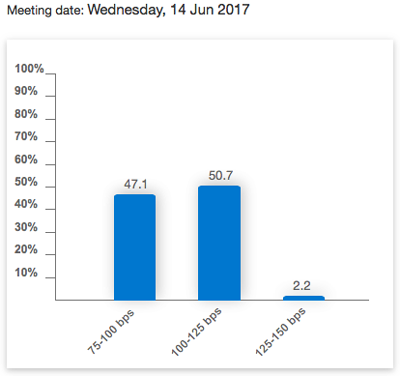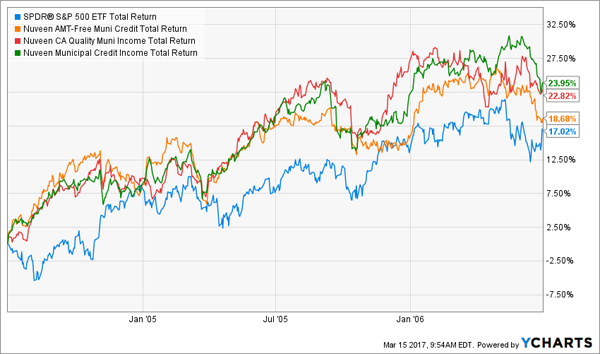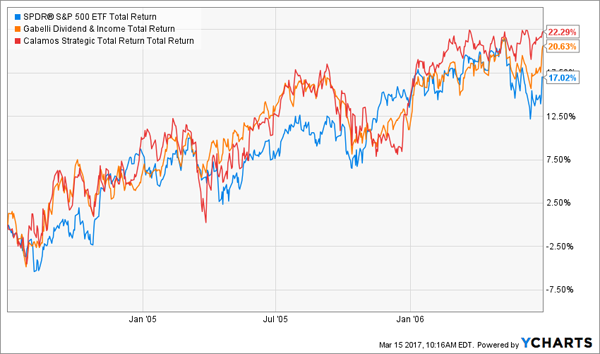Thinking of avoiding closed-end funds, now that we’ve got another Fed rate hike in the books?
It’s easy to see why, with the “smart money”—traders betting through the Fed funds futures market—expecting another hike just three months from now. In all, the market’s calling for three hikes this year, and so is Janet Yellen.
One Down, Two to Go?

But if you let that scare you away from high-yield sectors like CEFs, real estate investment trusts and preferred shares, you’ll miss out on some serious income.
In a moment, I’ll show you how to pick the CEFs with the most upside, along with the high payouts these funds are known for.
First, here’s why I’m pounding the table on them now.
Busting a Big CEF Myth
When many folks think of CEFs, the first word that comes to mind is leverage, and the risk that funds’ borrowing costs will spike along with rates.
And it’s certainly true that borrowed cash plays a big part in CEFs’ outsized dividend payouts.
Take the Calamos Strategic Total Return Fund (CSQ), one of the oldest equity-based CEFs (CSQ holds 63% of its portfolio in common stocks, with the rest in corporate bonds, convertible bonds and preferred shares).
Thanks to leverage, the fund’s management team can borrow cheaply, at around the LIBOR rate (more on that in a moment) to buy investments with higher returns. The difference heads out to investors in the form of dividends.
It’s why CSQ can hold stocks with middling dividend yields, like Apple (AAPL) and JPMorgan Chase & Co. (JPM), yet hand its shareholders a 9.0% payout.
So it’s no wonder CEF investors are concerned. But history suggests now is not the time to avoid the space—it’s time to get greedy for yield instead.
To see why, let’s look at the last rising-rate period, from July 2004 through June 2006. Back then, the 3-month LIBOR rate, which moves in lockstep with the Fed funds rate, spiked to 5.48%. And at 1.7% at the outset, LIBOR was starting at a much higher baseline than today’s 1.1%.
That’s an explosion—and it should have demolished CEFs, right?
Wrong.
Of the 10 largest CEFs by assets under management (AUM) today, six were around then—and all posted double-digit total returns during that two-year span. What’s more, their average return of 17.4% bested the S&P 500’s 17.0%.
And three—the Nuveen AMT-Free Municipal Credit Income Fund (NVG), the Nuveen California Quality Municipal Income Fund (NAC) and the Nuveen Municipal Credit Income Fund (NZF)— beat the market handily.
Muni-Bond CEFs Rose With Rates…

It’s true that all three of these are municipal-bond funds, which are the biggest CEF category by AUM. But popular stock-based CEFs—such as CSQ and the Gabelli Dividend & Income Trust (GDV), run by famed value investor Mario Gabelli—did just fine, too:
… And So Did Equity Funds

The bottom line?
We’ve still got a long way to go (and likely not in this rate-hike cycle) before rising rates become a significant headwind for CEFs. And we can give ourselves some extra protection by zeroing in on funds with reasonable leverage.
That’s easy: right now, the average CEF’s leverage is equal to 33% of AUM, so any fund with a ratio below that will have less to fear from higher borrowing costs. CSQ qualifies, at 29.8%, as does GDV, at just 23.9%.
My No. 1 Rule: Buy the Disappearing Discount
So put your rate fears aside.
Because there’s something else that will have a far greater impact on your CEF returns: a fund’s discount to net asset value (NAV), and more important, whether management has a plan to narrow that discount.
Here’s what I’m talking about: unlike an ETF, a CEF can’t issue new shares after its IPO. That means the fund can (and many do) trade at a discount to NAV.
That’s great for us, because it’s basically free money.
Right now, for example, GDV, which yields a nice 6.3%, trades at a 9.8% discount to NAV, so we’re getting $1 of assets for just $0.90! But that doesn’t mean much to us if that discount window never closes, as is the case with the vast majority of CEFs.
How can it close?
One way is if management simply shutters the fund. For example, Gabelli could close GDV today and give investors $23.10 in cash (the NAV) per share, rather than the $20.91 GDV trades for. In reality, the shares would likely jump to that level, which is what happened when the Allianz International & Premium Strategy Fund shut down at the end of 2013.
Other times, a CEF discount can simply disappear as investors pile into a hot sector.
Take the John Hancock Financial Opportunities Fund (BTO), which was trading at a 3.8% discount 13 months ago. Fast-forward to today, and BTO trades at a 2.6% premium to NAV after investors flocked to financials. The resulting 56.4% jump in NAV and the elimination of the discount sent the shares up 69.2% in just 13 months!
Discount Vanishes, BTO Soars

Watch for a Buyback Boost
For those of us with less luck than folks holding BTO or the shuttered Allianz fund I mentioned earlier, there’s another way a fund’s management can juice its gains: share buybacks.
And here’s where a management team with a keen eye for value can make a big difference.
Take BTO. Last year, managers Lisa Welch, Susan Curry and Ryan Lentell helped close the fund’s discount by repurchasing 10,000 shares, up from zero in 2015. (They’re also authorized to buy up to 10% of BTO’s outstanding shares this year, but I expect they’ll hold off now that the fund trades at a premium.)
Meantime over at GDV, Gabelli can buy back shares anytime the fund trades at a discount greater than 7.5%. That was the case last year, when the markdown averaged 11.3%. Gabelli, for his part, did better than that, buying back 117,996 shares at an average discount of roughly 13.7% from NAV.
Well-timed buybacks like these are gifts that keep on giving. Not only do they help close the discount window, but they also lift NAV per share as the stock is removed from the market.
The problem? All three of these CEFs lean heavily toward stocks, and when stocks got crushed in 2008, all three saw their NAV evaporate: CSQ’s plunged 51%, GDV’s by 46% and BTO’s by 37%.
I don’t want to get hit like that when the next crash comes—and I don’t want you to, either. That’s why I recommend diversifying by adding other types of funds trading at even deeper discounts than these three—in the 10% to 15% range.
Like the 3 CEFs in my new “No-Withdrawal retirement portfolio.” Their fat discounts mean these stealth funds will simply trade flat the next time the market craters.
More likely, the herd will quickly get over its interest rate fears—especially after the Fed sounded a cautious note on last week’s hike—and pile in, banishing those discounts in a hurry!
Translation: Quick double-digit upside for you and me.
Then there are the dividends. With payouts of 8.2%, 9.9% and even 10.1%, you can drop, say, $400,000 into these 3 beauties and trigger a nice $38,000 income stream—starting today!
The time to buy is now … before the rate fear dies down and our chance to buy cheap evaporates. Click here to get the names of these 3 CEFs and the other high-yield investments inside my unique portfolio now.
